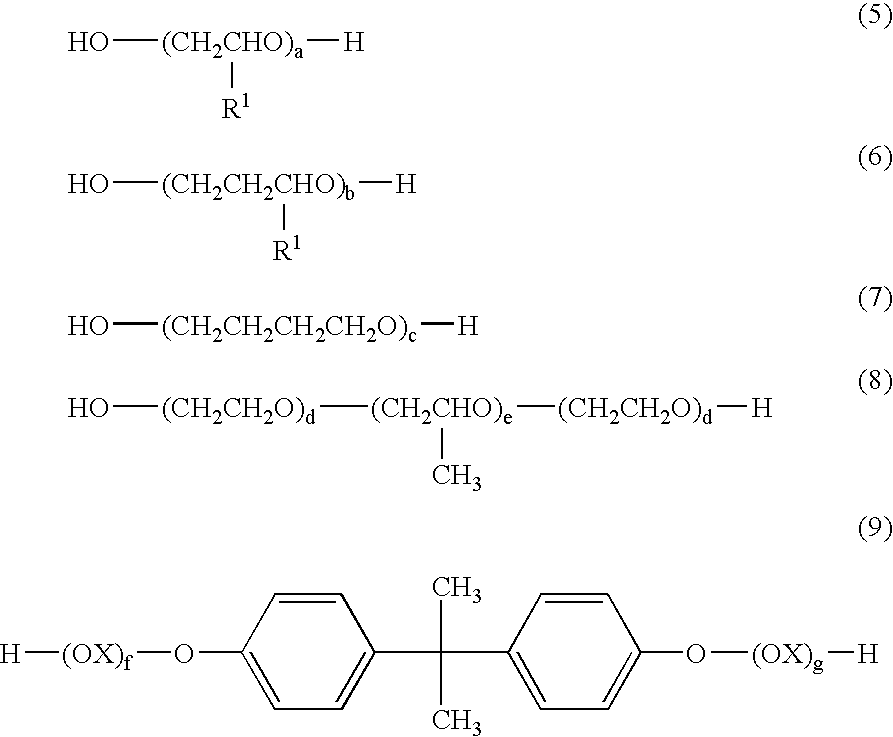Image recording material
a negative-type, image-recording technology, applied in the direction of lithography, photosensitive materials, instruments, etc., can solve the problems of poor plate life, low adhesion in the interface between the photosensitive layer and the substrate, and polluted optical systems
- Summary
- Abstract
- Description
- Claims
- Application Information
AI Technical Summary
Benefits of technology
Problems solved by technology
Method used
Image
Examples
synthesis example 1
Polyurethane Resin 1
In a three-neck round bottom flask equipped with a condenser and a stirrer of 500 mL, 2,2-bis(hydroxymethyl) butyrate of 8.2 g (0.05 mole) and trimethylolpropanemonoarylether of 7.8 g (0.05 mole) were dissolved in N,N-dimethylacetamide of 100 mL. To this, 4,4-diphenylmethanediisocyanate of 20.0 g (0.08 mole), 1,6-hexamethylenediisocyanate of 3.4 g (0.02 mole) and dibutyltindilaurate of 0.1 g were added, heated and stirred for 8 hours at 100° C. Subsequently, it was diluted with N,N-dimethylformamide of 100 mL and methylalcohol of 200 mL. A reactive solution was madeup while stirring in water of 3 L, white polymer was separated out. The relevant polymer has been filtered off, after washing with water, an amount of 32 g of the polymer was obtained by drying it under vacuum.
As the molecular weight has been measured by gel permeation chromatography (GPC), the weight average molecular weight (polystyrene standard) was 110,000. Further, as the content of carboxyl group...
synthesis example 2
Polyurethane Resin 21
2,2-bis(hydroxymethyl)propionic acid of 10.3 g (0.077 mole) and polypropylene glycol (weight average molecular weight) of 23.0 g (0.023 mole) were dissolved in N,N-dimethylacetamide of 100 mL. To this, 4,4′-diphenylmethanediisocyanate of 20.0 g (0.08 mole), hexamethylenediisocyanate of 3.4 g (0.02 mole) were added, reacted and post-treated similarly to the case of Synthesis example 1. An amount of 80 g of the polymer was obtained.
As the molecular weight has been measured by gel permeation chromatography (GPC), the weight average molecular weight (polystyrene standard) was 100,000. Moreover, as the content of a carboxyl group (acid value) was measured by titration, it was 1.35 meq / g.
Hereinafter, polyurethane resins (polyurethane resin 1-polyurethane resin 28) of the present invention were synthesized by employing a diisocyanate compound and a diol compound indicated in the following Table 1-Table 5 similarly to Synthesis example 1 or Synthesis example 2. Furtherm...
examples 11-13
Except that the components of photosensitive layer coating liquid in the Example 1 was changed to the following components, similarly the planographic original plate was obtained, the printing plate was obtained by performing laser scanning exposure and developing treatment under the conditions similar to Example 1. The printing plate was printed in a similar manner, sensitivity, plate life and stain were evaluated. Moreover, after the obtained planographic original plates were conserved at 60° C. for 3 days, respectively, and stored at 45° C. at moisture 75% RH for 3 days, the printing similar to the aforementioned was carried out and the results were indicated in Table 8.
<Photosensitive layer coating liquid (P-3)>Polyurethane resin (A)(compound indicated inTable 8, amountindicated in Table 8)Radical polymerizable compound (B)(compound indicated inTable 8, amountindicated in Table 8)Infrared rays absorbent agent “IR-6” (C)0.08gIodonium salt “I-1” (D)0.30gNaphthalene sulfonic a...
PUM
| Property | Measurement | Unit |
|---|---|---|
| wavelength | aaaaa | aaaaa |
| heat | aaaaa | aaaaa |
| of wavelength | aaaaa | aaaaa |
Abstract
Description
Claims
Application Information
 Login to View More
Login to View More - R&D
- Intellectual Property
- Life Sciences
- Materials
- Tech Scout
- Unparalleled Data Quality
- Higher Quality Content
- 60% Fewer Hallucinations
Browse by: Latest US Patents, China's latest patents, Technical Efficacy Thesaurus, Application Domain, Technology Topic, Popular Technical Reports.
© 2025 PatSnap. All rights reserved.Legal|Privacy policy|Modern Slavery Act Transparency Statement|Sitemap|About US| Contact US: help@patsnap.com



